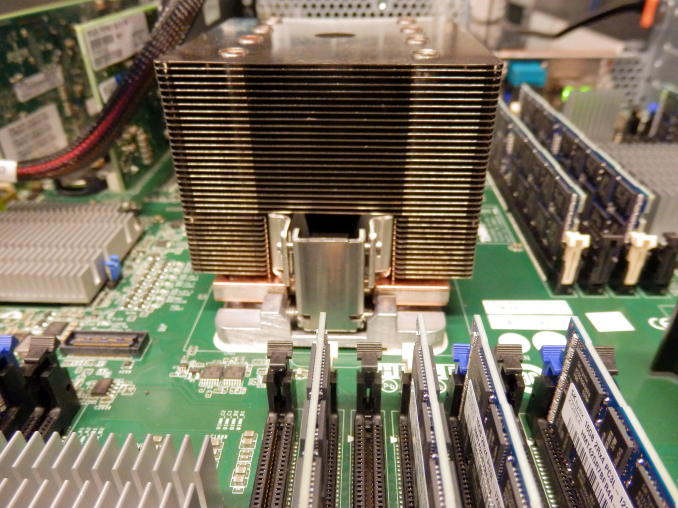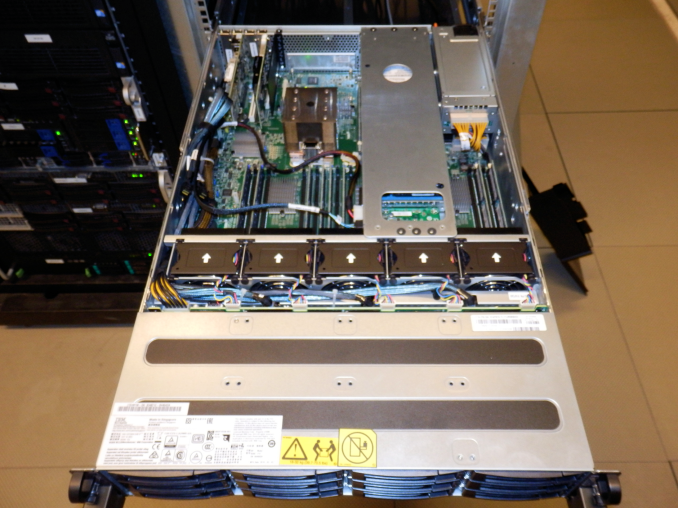Assessing IBM's POWER8, Part 1: A Low Level Look at Little Endian
by Johan De Gelas on July 21, 2016 8:45 AM EST
It is the widest superscalar processor on the market, one that can issue up to 10 instructions and sustain 8 per clock: IBM's POWER8. IBM's POWER CPUs have always captured the imagination of the hardware enthusiast; it is the Tyrannosaurus Rex, the M1 Abrams of the processor world. Still, despite a flood of benchmarks and reports, it is very hard to pinpoint how it compares to the best Intel CPUs in performance wise. We admit that our own first attempt did not fully demystify the POWER8 either, due to the fact that some immature LE Linux software components (OpenJDK, MySQL...) did not allow us to run our enterprise workloads.
Hence we're undertaking another attempt to understand what the strengths and weaknesses are of Intel's most potent challenger. And we have good reasons besides curiosity and geekiness: IBM has just recently launched the IBM S812LC, the most affordable IBM POWER based server ever. IBM advertises the S812LC with "Starting at $4,820". That is pretty amazing if you consider that this is not some basic 1U server, but a high expandable 2U server with 32 (!) DIMM slots, 14 disk bays, 4 PCIe Gen 3 slots, and 2 redundant power supplies.
Previous "scale out" models SL812 and SL822 were competitively priced too ... until you start populating the memory slots! The required CDIMMs cost no less than 4(!) times more than RDIMMs, which makes those servers very unattractive for the price conscious buyers that need lots of memory. The S812LC does not have that problem: it makes use of cheap DDR3 RDIMMs. And when you consider that the actual street prices are about 20-25% lower, you know that IBM is in Dell territory. There is more: servers from Inventec, Inspur, and Supermicro are being developed, so even more affordable POWER8 servers are on the way. A POWER8 server is thus quite affordable now, and it looks like the trend is set.
To that end, we decided that we want to more accurately measure how the POWER8 architecture compares to the latest Xeons. In this first article we are focusing on characterizing the microarchitecture and the "raw" integer performance. Although the POWER8 architecture has been around for 2 years now, we could not find any independent Little Endian benchmark data that allowed us to compare POWER8 processors with Intel's Xeon processors in a broad range of applications.
Notice our emphasis on "Little Endian". In our first review, we indeed tested on a relatively immature LE Ubuntu 14.04 for OpenPOWER. Some people felt that this was not fair as the POWER8 would do a lot better on top of a Big Endian operating system simply because of the software maturity. But the market says otherwise: if IBM does not want to be content with fighting Oracle in an ever shrinking high-end RISC market, they need to convince the hyper scalers and the thousands of smaller hosting companies. POWER8 Server will need to find a place inside their x86 dominated datacenters. A rich LE Linux software ecosystem is the key to open the door to those datacenters.
When it comes to taking another crack at our testing, we found out that running Ubuntu 15.10 (16.04 was just out yet when we started testing) solved a lot of the issues (OpenJDK, MySQL) that made our previous attempt at testing the POWER8 so hard and incomplete. Therefore we felt that despite 2 years of benchmarking on POWER8, an independent LE Linux-focused article could still add value.











124 Comments
View All Comments
DomOfSF - Thursday, July 21, 2016 - link
Johan de Gelas: blowing minds and educating "the rest of us" since...I dunno, a really long time ago (especially in internet years). Great job on the data, but the real good stuff is in your thoughts and analysis. Thank you!close - Saturday, July 23, 2016 - link
Over a decade...JohanAnandtech - Thursday, July 28, 2016 - link
13 years in the server business, 18 years now of reviewing hardware :-). Thx !!jamyryals - Thursday, July 21, 2016 - link
It seems to me, Intel's focus on bringing their CPU architecture design all the way down to 5W is the reason IBM is able to stand out against them. Intel is focused on creating a scalable architecture while IBM can throw the whole kitchen sink at the server market.Fascinating article, I really enjoyed it.
smilingcrow - Thursday, July 21, 2016 - link
Intel has plenty of unique features in their server platforms which aren't in the consumer platforms so I don't think that is the issue.jospoortvliet - Tuesday, July 26, 2016 - link
The basic design of the core still is the same so there is probably at least some truth in the statement of Jamy.Kevin G - Wednesday, July 27, 2016 - link
Up until this point. Consumer SkyLake and server SkyLake are going to be two different designs. They're certainly related but server SkyLake will have 512 KB of L2 cache per core and support AVX-512 instructions.Server SkyLake is also going to support 3D Xpoint DIMMs, though that difference is more with the platform/chipset than the actual CPU core.
floobit - Thursday, July 21, 2016 - link
Very interesting. It seems odd to me that they chose to configure it in a 2U - except for big data clusters, most of the market space I see this playing is dominated by FC to a SAN. Is this a play in the big data cluster space, or the more traditional AIX/DB2/big iron that IBM has owned for so long?Some questions I'd have:
what virtualization is possible with this architecture? presumably just the standard PowerVM? How well does that work?
What is the impact of IO latency? Could you throw a P3700 or two in here?
JohanAnandtech - Thursday, July 21, 2016 - link
2U: Besides big data storage needs, I suspect 2U is necessary for adequate cooling for the POWER8 chip.Virtualization: Linux KVM works well as far as I know.
We actually tried out a P3700 in there (see: http://www.anandtech.com/show/9567/the-power-8-rev... ) and it worked very well. I asked IBM what a customer should expect when using third party storage (probably no support, but how about waranty?) but no answer yet.
mystic-pokemon - Friday, July 22, 2016 - link
Hi Johan2U is not necessary for cooling a POWER 8 Chip. We do that better with our Barreleye (1.25 OU design). Even storage wise Barreleye has 15 Disk storage bay that can be seen in below links.
http://www.v3.co.uk/v3-uk/news/2453992/google-and-...
Let me know if you wanna ever benchmark a Barreleye. What specific POWER8 proc are you benchmarking with ? (Turismo?). I believe it does slightly better than S812LC on many benchmarks based on the variant of power8 proc S812LC runs.